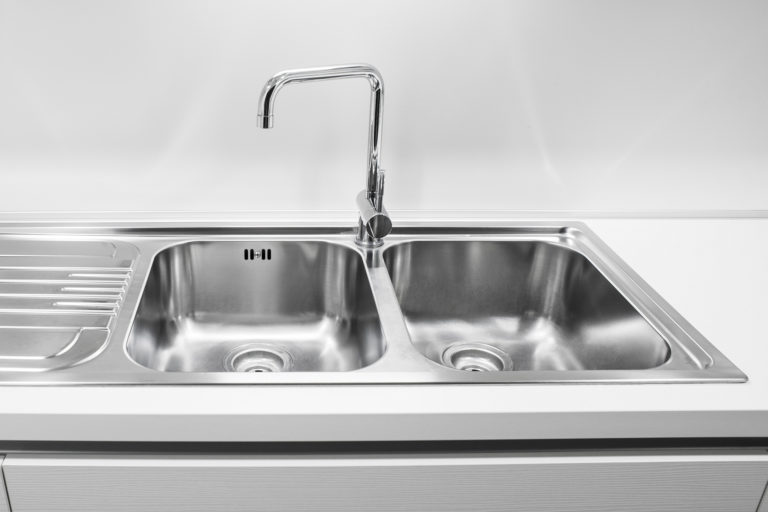
Quick Tips
- First, rinse the whole sink with water.
- Sprinkle baking soda over the entire sink.
- Scrub the stainless steel sink basin and fixtures with a soft- to medium-bristled brush.
- After you've finished scrubbing, spray undiluted white vinegar over the baking soda residue left on the sink.
- Use the same process to clean sink strainers and any other stainless steel pieces that aren't attached to the sink.
- Rinse the sink with tap water.
My husband and I moved into our current apartment after renting a series of “charming” (old) apartments, and by the time we got here, one of the elements of architectural character I was beyond ready to live without was antique porcelain sinks. Because unless you’re a fan of chlorine bleach (and I’m not), porcelain sinks can be a challenge to clean—and then there’s the even bigger problem of keeping them that way. By comparison, the stainless steel kitchen sink I have now is a housekeeper’s wet dream: stains can’t stick and grease just temporarily dulls the metal.
Of course, even a stainless steel sink occasionally needs a good, thorough cleaning. Wiping it out with a damp, soapy rag after washing the dishes will keep it reasonably clean, but water spots, grease, and stubborn food particles eventually demand a tougher approach. When it comes to that, some people dump bleach-infused scouring powder in their stainless steel sinks, but I prefer a healthier, more environmentally conscious method of disinfecting and polishing stainless steel.
Steps to Cleaning a Stainless Steel Sink
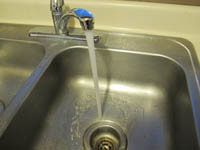 First, rinse the whole sink with water. Rinsing does three important things: it clears the surface of dust and loose bits of food or other debris, it softens caked-on gunk, and it puts a damp layer over the stainless steel surface for baking soda to cling to in the next step. I usually just use my hands to splash and rub water over every surface of the sink, including the faucet and the rim along the countertop, but if you’d rather use a rag, go for it. Now is also a good time to moisten your scrub brush under the tap.
First, rinse the whole sink with water. Rinsing does three important things: it clears the surface of dust and loose bits of food or other debris, it softens caked-on gunk, and it puts a damp layer over the stainless steel surface for baking soda to cling to in the next step. I usually just use my hands to splash and rub water over every surface of the sink, including the faucet and the rim along the countertop, but if you’d rather use a rag, go for it. Now is also a good time to moisten your scrub brush under the tap.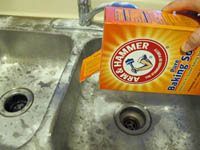 Sprinkle baking soda over the entire sink. You’ll be cleaning the rim of the sink and the faucet as well as the basin, so don’t forget to dust some baking soda over those, too. Baking soda makes a great stainless steel sink cleaner because it’s abrasive enough to scrub away light hard water deposits and stuck-on grease and food, but not so abrasive as to scratch shiny stainless steel fixtures like faucets. And because it’s a food product, you don’t have to worry about chemical residues coming in contact with your dishes.
Sprinkle baking soda over the entire sink. You’ll be cleaning the rim of the sink and the faucet as well as the basin, so don’t forget to dust some baking soda over those, too. Baking soda makes a great stainless steel sink cleaner because it’s abrasive enough to scrub away light hard water deposits and stuck-on grease and food, but not so abrasive as to scratch shiny stainless steel fixtures like faucets. And because it’s a food product, you don’t have to worry about chemical residues coming in contact with your dishes.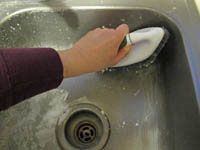 Scrub the stainless steel sink basin and fixtures with a soft- to medium-bristled brush. I actually like to use two brushes for this step: a large scrub brush for the basin and the rim of the sink, and a smaller grout brush for the faucet and around the inside of the drains. An old toothbrush would also work well for the detail work around edges and on smaller surfaces.
Scrub the stainless steel sink basin and fixtures with a soft- to medium-bristled brush. I actually like to use two brushes for this step: a large scrub brush for the basin and the rim of the sink, and a smaller grout brush for the faucet and around the inside of the drains. An old toothbrush would also work well for the detail work around edges and on smaller surfaces.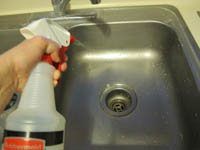 After you’ve finished scrubbing, spray undiluted white vinegar over the baking soda residue left on the sink.The vinegar and baking soda will fizz when they come into contact with each other. I like to imagine that this foaming action helps to remove grease and grime, but I can’t prove it. What I can back up with science is that vinegar is a pretty powerful disinfectant: some studies have shown that it can kill up to 99 percent of bacteria and 80 percent of viruses. Plus, vinegar’s acidity works to dissolve alkaline calcium deposits and water spots, which makes it awesome for cleaning stainless steel sinks.
After you’ve finished scrubbing, spray undiluted white vinegar over the baking soda residue left on the sink.The vinegar and baking soda will fizz when they come into contact with each other. I like to imagine that this foaming action helps to remove grease and grime, but I can’t prove it. What I can back up with science is that vinegar is a pretty powerful disinfectant: some studies have shown that it can kill up to 99 percent of bacteria and 80 percent of viruses. Plus, vinegar’s acidity works to dissolve alkaline calcium deposits and water spots, which makes it awesome for cleaning stainless steel sinks.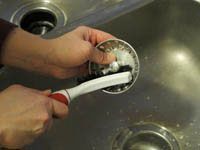 Use the same process to clean sink strainers and any other stainless steel pieces that aren’t attached to the sink. Set them in the bottom of the sink or hold them in one hand while dusting them with baking soda, scrubbing them with a small scrub brush or toothbrush, spraying them with vinegar and watching it fizz in reaction with the baking soda, and finally rinsing them under the tap. I suggest doing this before rinsing the sink so you won’t have to rinse it a second time after you splatter baking soda and grime into it while cleaning the smaller pieces.
Use the same process to clean sink strainers and any other stainless steel pieces that aren’t attached to the sink. Set them in the bottom of the sink or hold them in one hand while dusting them with baking soda, scrubbing them with a small scrub brush or toothbrush, spraying them with vinegar and watching it fizz in reaction with the baking soda, and finally rinsing them under the tap. I suggest doing this before rinsing the sink so you won’t have to rinse it a second time after you splatter baking soda and grime into it while cleaning the smaller pieces.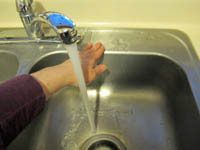 Rinse the sink with tap water. I like to use my bare hands when rinsing, instead of a rag, so I can feel the slight grittiness wherever baking soda residue still needs to be rinsed away. Once you’ve finished rinsing it, your sink should be pretty shiny, but if it isn’t quite meeting your sparkle standards, you can polish stainless steel by buffing olive oil onto it with a soft, dry cotton rag. This is also a good time to clean your garbage disposal, if you have one, by grinding a few ice cubes or a halved lemon in it.
Rinse the sink with tap water. I like to use my bare hands when rinsing, instead of a rag, so I can feel the slight grittiness wherever baking soda residue still needs to be rinsed away. Once you’ve finished rinsing it, your sink should be pretty shiny, but if it isn’t quite meeting your sparkle standards, you can polish stainless steel by buffing olive oil onto it with a soft, dry cotton rag. This is also a good time to clean your garbage disposal, if you have one, by grinding a few ice cubes or a halved lemon in it.
How to Remove Hard Water Stains on Stainless Steel
Even if you have soft water, you probably get water spots on your stainless steel sink because the minerals that cause hard water deposits are present, in varying concentrations, in all water. The best way to remove limescale or water spots, which are composed primarily of an alkaline compound called calcium carbonate, is to dissolve them with an acid like vinegar or lemon juice.
Light water stains will probably come off during the cleaning process described above, but cleaning calcium deposits built up around the faucet requires an extra step. Soak a rag in undiluted white vinegar or lemon juice and lay it over the affected area. Let the rag sit for up to an hour to soften the limescale before scrubbing it with a grout brush. Afterward, rinse well with water.
Natural Stainless Steel Cleaners
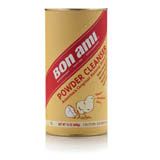 Bon Ami products are formulated with only natural, biodegradable, nontoxic ingredients for safe and environmentally conscious cleaning. The company offers a selection of cleaners, including liquid solutions in bottles made from 100% post-consumer recycled plastic, but Bon Ami Powder Cleanser is especially well-suited for cleaning stainless steel sinks.
Bon Ami products are formulated with only natural, biodegradable, nontoxic ingredients for safe and environmentally conscious cleaning. The company offers a selection of cleaners, including liquid solutions in bottles made from 100% post-consumer recycled plastic, but Bon Ami Powder Cleanser is especially well-suited for cleaning stainless steel sinks.
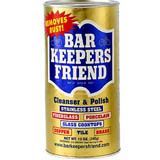 Bar Keepers Friend is available as either a powder or a mildly abrasive liquid cleanser. It contains no chlorine bleach and relies instead on oxalic acid, which occurs naturally in many plants as well as the human body, to remove stains, limescale, and rust from stainless steel. You can find Bar Keepers Friend on Amazon.
Bar Keepers Friend is available as either a powder or a mildly abrasive liquid cleanser. It contains no chlorine bleach and relies instead on oxalic acid, which occurs naturally in many plants as well as the human body, to remove stains, limescale, and rust from stainless steel. You can find Bar Keepers Friend on Amazon.
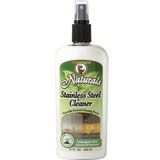 Howard Naturals Stainless Steel Cleaner is a liquid stainless steel polish and cleanser. It contains only natural, plant-derived oils and cleaning agents, and can be used to clean stainless steel appliances as well as kitchen sinks. Because it is completely non-abrasive, it’s a good choice for cleaning high-shine stainless steel fixtures like faucets.
Howard Naturals Stainless Steel Cleaner is a liquid stainless steel polish and cleanser. It contains only natural, plant-derived oils and cleaning agents, and can be used to clean stainless steel appliances as well as kitchen sinks. Because it is completely non-abrasive, it’s a good choice for cleaning high-shine stainless steel fixtures like faucets.